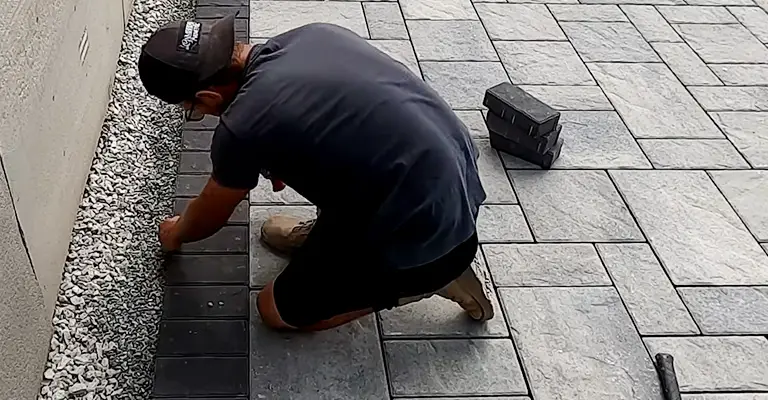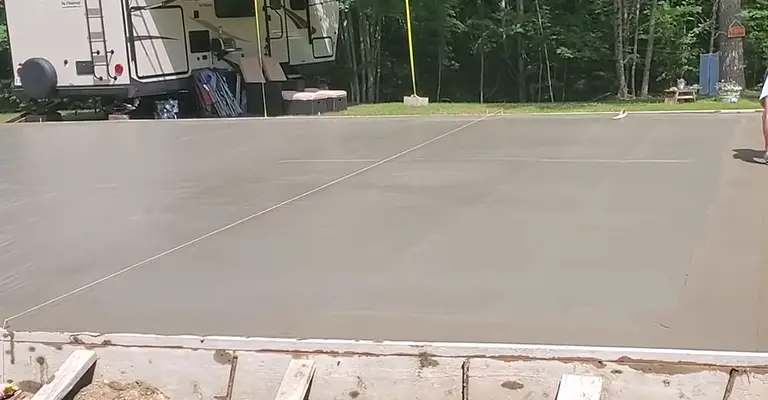Ever thought about putting concrete on top of those stone blocks in your yard? Well, it’s possible! But before you go ahead, there are some important things you need to know.
Make the concrete 4″ thick and add rebar if you are adding it over pavers. Concrete can move. And the fact that concrete can move means it will probably continue to do so. Your pavers will not adhere to it.
Pave over, but avoid skimming to level out the surface. The cover won’t adhere, and freezing might be a problem if water gets inside.
As a result of the additional concrete, you may have to adjust your height. Concrete can also be poured over bricks. On the other hand, you cannot pour concrete over flagstones.
In order to determine the proper use of pavers, we consulted landscapers and designers. Check out this post for some tips on renovating your home, specifically about pouring concrete over pavers.
Can You Pour Concrete Over Pavers?
Pavers are decorative stones that can be used in landscaping. Maintaining an orderly garden, patio, or walkway is very easy with these.
Around the pool, you could even see pavers. Over time, you might want to renovate a particular design if you have been using it for a long time.
Pavers are a popular choice for homeowners who want to keep their landscape neat and tidy. There are many types of pavers, including bricks, concrete, stone, travertine, porcelain, and cobblestones.
The rough surface of these stones prevents slips, especially on wet ground. You might want to change your property’s layout at some point even if you enjoy the look of pavers.
It may start to bother you when weeds grow on your concrete tiles. Maybe you want to try something new. But you don’t have enough time to take each tile out one by one. You could pour concrete over them. Does it seem feasible?
Contractors say this is possible. Ideally, if you wish to do it correctly. The steps are as follows:
- The original pavers should be laid out on a solid foundation. There should also be no cracks in the tiles.
- Use a broom to remove dirt from the pavers’ surfaces. Clean up any debris left behind with a pressure washer.
- Liquid detergents or degreasers may also be used by some contractors for a more thorough cleaning.
- The pavers should be covered with plastic, then sand should be poured on top. Compact the sand well.
- Fresh concrete should be poured over the tiles.
Pouring Concrete Over Flagstones

Flagstones should be laid over concrete, not the other way around, according to contractors.
In the case of placing flagstones next to each other, ensure that they are properly positioned and fitted. Before the concrete hardens, you should place the flagstones.
Pouring Concrete Over Bricks
Concrete can be poured over bricks just like pavers. If you are going to pour concrete on top of bricks, you should spread gravel and sand on top first.
Under heavy pressure, bricks tend to crack. You might get surprised when your concrete cracks if this material is used as a base.
Specialized Concrete For Use Over Your Pavers

For projects requiring strength or consistency that ordinary concrete cannot provide, specialized products are available.
Fiber-reinforced Concrete
After laying a concrete layer, you might want to build a gazebo, a garage, or some other structure over the area but aren’t sure if the surface will hold up. Instead of ordinary material, use fiber-reinforced material.
Fibers made from steel, glass, and plastic compounds are woven into the cement and aggregate base mixture. Specialized concrete creates a long-lasting, structurally durable surface once it sets.
A driveway with several vehicles, a heavy truck, or a high traffic area would be ideal for this product.
If the facility must be used sooner (like a driveway or a footpath leading to a house), the long curing time may also be a problem.
Fast-track Concrete
It can be a hassle to wait two weeks to a month for the surface to cure, particularly if it has to be accessible for two weeks to a month after application.
To access other areas of the property, you may need to use the patio or walkway to gain access over the driveway or garage. The curing process is accelerated by the use of hardeners in fast-track concrete.
It is common to use them for repairing highways, airports, and other traffic-heavy areas that require quick accessibility. Within 12 hours, the specialized concrete reaches its maximum strength.
Is It Better To Use Cement Instead Of Concrete?
Cement and concrete are often confused. The durability of concrete, however, is well known. Large-scale projects can also be handled with it.
Since cement is composed of calcium and silica, it is more appropriate for smaller tasks. Cement can be used for minor home improvements. Concrete and cement are also mixed together.
If you want to improve your patio or walkway, you should use concrete since it will last longer. Concrete will last for several decades if it is properly cared for. It’s worth the money you spend.
To change or remodel any area around your home, concrete can be applied over pavers in a convenient, practical, and less complicated way.
You will have a better chance of success if you take into account the material of the pavers, the purpose of the concrete, and the proper way to apply it.
How Long Before The Concrete Hardens?

You will have to wait two days after pouring concrete over the pavers before walking or driving over them. To prevent cracks on the surface of the concrete, contractors require it to be cured for some time.
A period of about 28 days is ideal. You can drive heavy vehicles over the concrete during that time period as it has fully hardened.
Concrete will also dry faster at a high temperature. Moisture evaporates quickly when it’s hot.
How Thick Does The Concrete Overlay Need To Be?
A thickness of about 1 to 2 inches would be ideal. You can improve your property by pouring concrete on your driveway.
Using this method will also result in a lower cost, since you can cover the tiles you don’t want to use anymore. Because concrete lasts longer, you will also save on future labor costs.
Can You DIY Pouring Of Concrete?
The cement can be poured over the desired area by a contractor if you decide to do this project. As long as you have the skills and equipment, you can also do it yourself.
It even saves you money on expenses. As you are doing everything on your own, you will have to do additional legwork.
If you are pouring concrete on a small area, you can use a wheelbarrow. You can, however, use a small cement mixer for a relatively larger area. Despite renting some equipment, you’ll still save money in the long run.
Final Words
Your yard’s pavers serve both a functional and aesthetic purpose. There is no danger of tripping over these, and they are pleasant to look at. You might want to get rid of pavers at some point in order to improve your property.
However, it would be time-consuming to remove them one at a time. You are in good company if you decide to pour concrete over the pavers.
In addition to contractors and builders, this practice is also common in the industry. Concrete can only be poured without cracks in the pavers, so make sure they are free from them.








